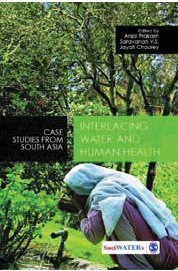An increasing recognition of the need to understand the complex systems in the health sector has raised the demand for an examination of water and health from a systemic perspective. Analyzing the various discourses on the subject, the volume revolves around this central question: What are the linkages between water and health in South Asia?
The interlacing of water and health exists wherever human health is adversely affected, directly or indirectly, by changes in the quality and quantity of water. These adverse effects are linked with poverty, environment, and infrastructure in the overall socio-political and economic-developmental context.
The book looks at the linkage between water and health in an integrated manner, and is not based on the ‘absence of disease’ syndrome. The curative, preventive, and adaptive aspects of the public-health problem have also been delved into. Among other areas, the articles deal with water and health with reference to water supply, sanitation, water pollution, natural disasters, urbanization, and industrialization.
Armed with the latest research and case studies from South Asia, the book calls for a comprehensive understanding and better integration of water and health issues in the region.
Interlacing Water and Human Health is the third volume in the Water in South Asia Series published by SAGE and South Asia Consortium for Interdisciplinary Water Resources Studies (SaciWATERs).
To train farmers to grow cotton using less water. Based on the latest BCI harvest data available, in 2013, cotton farmers in China reduced their water use by 23 percent compared with farmers who were not using BCI techniques. LS&Co. plans to continue working with its global suppliers with the goal of sourcing approximately 75 percent Better Cotton by 2020, up from 6 percent today.
LS&Co. will also continue to work toward using less water during manufacturing by expanding the Water<Less™ process to include more Levi’s® products, such as tops. By 2020, the Levi’s® brand aims to make 80 percent of its products using Water<Less™ techniques, up from nearly 25 percent today.










